Where Sustainability Reporting is Headed and Why

December 17, 2020

Today, there’s an increased focus on sustainability as public interest in the topic continues to grow. Positive environmental effects from the drop in CO2 emissions during lockdown increased air pollution awareness and concerns. And waste is skyrocketing from heavy PPE usage, shopping online and ordering takeout to name a few. According to a GWI report, 72% of consumers say companies behaving sustainably is more important to them now because of COVID-19.
Added pressure is being put on businesses to not only implement more environmentally responsible practices, but also provide transparency into their goals and results. After all, people see claims of “going-green,” all-natural products, and energy-efficient production processes everywhere. In a world full of greenwashing, customers and investors want to know that beyond the usual marketing jargon, a company is actually making a quantifiable difference.
Why is sustainability reporting becoming so imperative?
Also referred to as a responsibility, citizenship or ESG report, a sustainability report shows how your business is contributing to a more positive future—environmentally, economically and socially. By showing concrete numbers and examples, it proves you have a genuine concern for the environment, your customers and employees.
Since it goes beyond environmental factors, it’s a great way to present how your business' governance model reflects and reinforces your strategy and values. And if your competitors aren’t reporting yet, it may not be long before they do so voluntarily. A study done by Refinitiv found that 54% of companies currently report on sustainability, and that number is only expected to increase as public demand grows.
After all, sustainability reporting has many benefits, including:
- Improves corporate commitment and implementation
- Leads to development of a more sustainable supply chain, reducing financial, social and environmental risks
- Uncovers innovation opportunities for operations and products
- Increases operational efficiency and lowers costs
- Builds a trustworthy and positive brand image
- Helps attract and retain customers and employees
- Provides a record of achievements to show progress and evaluate metrics
Since CSR reporting is found to increase a company’s commitment to and therefore effectiveness in achieving sustainable targets in the production process, more organization’s are providing sustainability compensation—incentives for executives have more than doubled in the last three years.
Key elements to include in your next report and why.
Here are essential elements to include and what you’ll want to consider for the years ahead, along with examples from a report we helped design for global electric motor manufacturer, Regal Beloit.
An update on your strategy, goals and achievements.
What is your strategy for reducing carbon emissions, energy consumption, water usage and waste? From sustainable manufacturing to your supply chain, explain how your organization reduces its environmental footprint. Include what steps leadership is taking, accountability measures in place and how your organization has progressed throughout the years.
With factories and offices closed during lockdown, many companies have reduced greenhouse gas emissions and energy and water consumption, so it will be important to communicate what numbers are actually a result of pre-existing efforts. And if you’ve been able to develop more sustainable operations as a result of the pandemic, explain how those changes are positively impacting your business going forward.
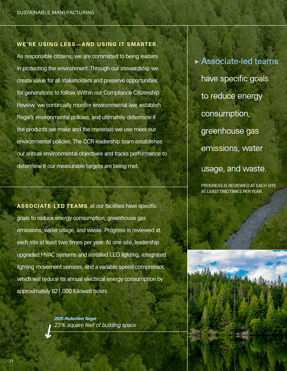
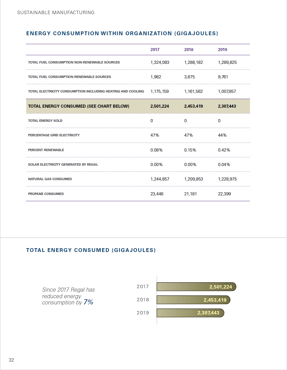
Regal affirms their dedication to sustainable manufacturing by explaining their strategy and progress since 2017, along with 2025 targets.
Efforts to better society and your workplace culture.
Corporate social responsibility initiatives have a huge impact on a brand’s image. As economic and social issues mount, organizations need to be responsive to current situations, from pure philanthropy efforts to improving or ensuring a positive workplace culture. Including diversity and inclusion metrics shows progress and promotion of equal opportunity at all levels, and health and wellness data proves your care and commitment to the wellbeing of employees and their families. People want to work for a company that engages their employees and is involved in positive activities that give back to their communities and causes they care about.
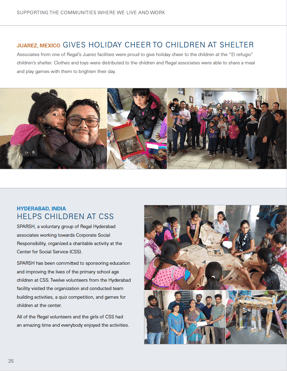
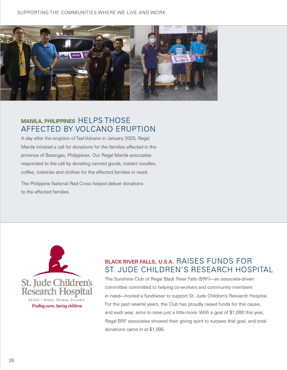
A look at how Regal associates are committed to corporate social responsibility, helping various charities through volunteering and donations.
The impact of COVID, your response, strategy and outlook.
The pandemic has amplified the impact ESG metrics have on investors’ decision-making. Stakeholders need to be assured of your company's financial resilience to make it through the pandemic, and what the strategy and expectations are for the future. There is also close scrutiny of how organizations are treating employees and suppliers, and if strides are being made to help the communities in which they operate. Showcase how your products or services have been essential—or adjusted—to help during the pandemic, as well as what measures you’ve taken to protect customers and employees. This will also boost employee morale and confidence in the company, during a challenging time.
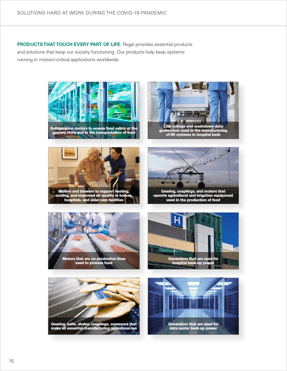
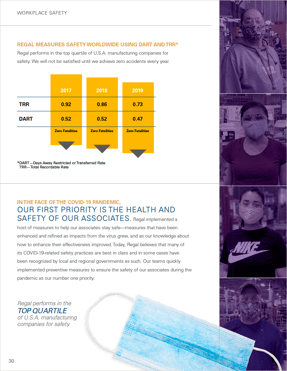
Throughout the report, Regal demonstrates how their products have been hard at work during the pandemic and special measures they’ve taken to safeguard employee health.
In today’s unsettled economic and social environment, it’s crucial for companies to report on what measures they're taking and have taken towards creating a better future for all stakeholders. Authenticate your organization’s commitment to continually improving its environmental, economic and social impacts.





